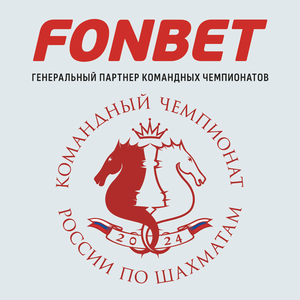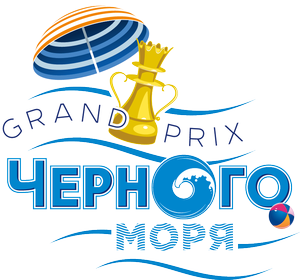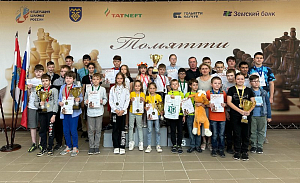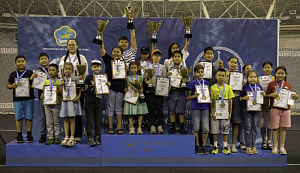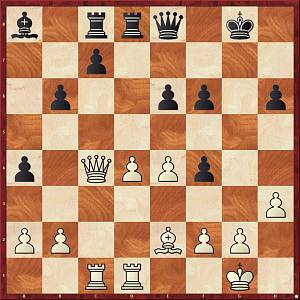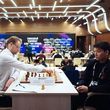25 May 2015
Secrets of opening preparation
The penultimate round of the Grand Prix reviewed by Vladimir Barsky.
Fabiano Caruana and Hikaru Nakamura started to crush each other in an open battle, and then suddenly got worried about other things. A sharp pawn race on opposite wings never took place, and the game ended in a perpetual on the 7th rank. Yet, this draw is like a victory for the two leaders of both the Khanty-Mansiysk tournament and the entire Grand Prix series.
The third leader of the Khanty-Mansiysk stage Lenier Dominguez fell from the tricky-minded Baadur Jobava. Lenier was replaced by the Russian Dmitry Jakovenko, who defeated his countrymen Sergey Karjakin.
Correct me if I am wrong, but I think Fabiano Caruana already secured his seat in the Candidates. The second ticket is up for grabs for Nakamura and Jakovenko, and they are playing each other in the last round – Nakamura has White, and he is content with a draw.
Vachier-Lagrave-Svidler draw
This was another example for Peter Svidler's future book “Secrets of Opening Preparation”: the potential author somehow managed to overlook Vachier-Lagrave-Krylov, Aeroflot open 2010. “I definitely had not seen this game, and I specifically looked for Maxime's game against the Zaitsev. After the previous three games I can be surprised by nothing, but this still would be a bit of an achievement by my side. That's bizzare, I will go and recheck”, Peter did not try to hide his surprise.
Peter Svidler and Maxime Vachier-Lagrave
White got a stable advantage in the Zaitsev System of the Ruy Lopez, using the plan from the aforementioned game. The French grandmaster was sure that his opponent worked on this endgame at home, but Svidler explained him that all his work was done at the board: “I needed to play very precise not to lose immediately”.
Both grandmasters praised 29...g6!, which prevented White from improving his position on the queenside easily, as Black would create a passed pawn on the h-file in reply. This forced White to switch to central play, but Svidler carried out a small exchange combination and equalized the game.
“After the events of the previous three days I thought: okay, we've made 33 moves, and my position does not look that bad, so maybe it was a good idea to offer Maxime a draw...” explained Peter Svidler his line of thought.
Gelfand-Tomashevsky draw
A sharp line of the Chebanenko Slav occurred in this game. According to Gelfand, many years ago he played this variation against Bacrot and obtained a lost position around the move 10. After that he naturally spent some time working on the variation, and today he selected the most principled 7.b3.
Tomashevsky said he worked on this line for about a week following Grischuk-Morozevich from the Petrosian Memorial 2014, and his analysis was quite deep. According the Evgeny, 14...0-0 is the most principled reply that leads to a critical position of the variation. Boris agreed with this assessment, saying “Black's plan is very simple, and if I do not manage to create problems for him immediately, the game may end really quickly.” – “Black's main idea is to put the queen on e7 and respond to b3-b4 by а6-а5. This idea is very strong, and the computer does not see it at once. The machine likes White very much, but becomes less and less optimistic over time.” (Tomashevsky).
Finally Black returned the pawn he sacrificed in the opening, equalized the game, and the players began to repeat moves.
Jobava-Dominguez 1-0
The players followed Jobava-Grischuk from the 4th round until the 13th move. That game ended in a spectacular draw: Black sacrificed a bishop and rook and gave the perpetual. Baadur found a new idea associated with an exchange sacrifice and even showed it at the press-conference: 13...Ba6 14.Re1 Ba5 15.Nxc6 Qh4 16.Re2!? (instead of 16.Nxa5 Rxf2! 17.Nc3 Rxg2+ with a draw) 16...Bxe2 17.Qxe2 Bb6 18.Nd2. However, he was unable to test it today, as Dominguez deviated first. Black developed his bishop to a more modest square b7 instead of a6, which was a surprise to Baadur.
Dominguez explained that he did not analyze Jobava-Grischuk deeply, but noticed that the machine likes 13...Bb7 better. Black got a playable position, but then made several poor moves.
Black carried out the freeing с6-с5 break and obtained decent counterplay. On the 17th move Dominguez could defend against a check with the queen, which would lead to an equal ending, however, he opted for a more complicated game, planning to create kingside pressure, and overestimated his chances. Black's queen on h5 was out of play while the main events were developing on the queenside and in the center. The b6-bishop was also placed awkwardly, and Dominguez decided to trade it for the e5-knight. This turned out to be a bad idea, as the Cuban GM missed a very strong response – 24.Rc1!, and the intended 24...Rfc8 fails to 25.Rc6! Black was forced to defend a very difficult position.
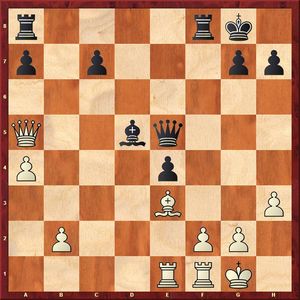
After Black's 23rd move
White's queenside attack yielded him an extra pawn in a rook ending, in addition Black's pawn on e4 was weak. White eventually won it and converted his advantage into a win.
Caruana-Nakamura draw
The players surprised each other with a highly original move order: 1.d4 c5!? 2.e4!? d6 3.Nf3, and suddenly there is a Sicilian on the board! Nakamura went for the Dragon Variation, which Caruana haven't faced for quite a while. Fabiano did not go for the sharpest lines and preferred to test his opponent in a quiet position with a slight advantage to White. Hikaru was well-prepared for that, too, and demonstrated a novelty on the 15th move, forcing further simplifications.
Hikaru Nakamura and Fabiano Caruana
After a short tactical battle a sharp four-rook ending arose. Three white pawns on the queenside and three black pawns on the kingside were going for a home run. However, it seems the leaders of the Grand Prix suddenly recalled about the series' leaderboard and decided to avoid any risk. They consistently rejected the sharpest continuations, and prior to the first control white rooks penetrated the 7th rank and forced a draw by perpetual.
Grischuk-Giri draw
Alexander Grischuk looked puzzled at the press-conference: “Nobody played this line of the Semi-Slav against me for many years, and here I played two games in a row!” In the 8th round Grischuk developed his bishop to g5 and defeated Karjakin, although Black had decent chances during the game. This time he preferred a more modest 5.е3.
The grandmasters played very solidly and soon blocked the center by f7-f5 and f2-f4. According to Giri, both players disrupted the opponent's plans, but it was unclear what to do next. The young Dutch player selected a daring plan with g7-g5 and added that he considered an even sharper continuation, but it did not work. “Black cannot play for an advantage!” smiled Grischuk. After that remark Giri agreed that he somewhat overestimated his position: “I thought I was almost winning, but after Alexander played 20.d5, it turned out that nothing works out on the kingside. After 25.b4 I lost faith in my position and only hoped for the opponent's time trouble.”
“Even without the time trouble it was a crazy position!” expressed him opinion the Russian grandmaster. Both kings were unsafe, and the pieces of both player were very active. Alexander decided to avoid risks and offered a draw after making his 32nd move. “Of course Grischuk was under time pressure, but with him it does not mean much, so I accepted the offer”, said Giri.
Both grandmasters were somewhat disappointed about the outcome and blamed the 30-move rule. Grischuk called it “an extremely stupid rule”, saying that draw offers should be allowed either from the move 1, or from the move 40, because the 30-move rule often interrupts games at the most interesting moment.
Jakovenko-Karjakin 1-0
This game ended last after 6 hours of struggle. “Sergey also had to play for a win, so he decided to choose an interesting but risky variation”, started the press-conference Dmitry Jakovenko. A critical position arose after White's 23rd move.
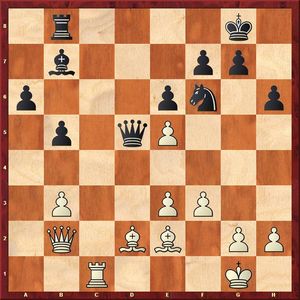
After White's 23rd move
“I was slightly worse after the opening, but the tournament situation forced me to play for a win. In other circumstances I would retreat the knight to d7 and try to survive”, said Sergey Karjakin. “23...Ng4 is a mistake – I missed the strong maneuver Bb4-d6 followed by Rc5, which basically forces Black to part with the queen. Dmitry played a very strong game.”
White could invade the enemy camp with his queen and take both a- and b-pawns, however, Jakovenko was worried about fortress ideas with a rook against a queen, so he tried to keep more pieces on the board to play for the attack.
This plan eventually worked, but not without some help from the opponent. Karjakin criticized 32...Kg7?, which allowed White to bring his pawn to f6 with check. This gave White a decisive advantage, but finding the wining idea took a while for Jakovenko, as Dmitry was really worried about not spoiling anything, like he did yesterday. Eventually he avoided all the traps and converted the queen, thus advancing to the joint first place.
Sergey Karjakin and Dmitry Jakovenko
* * *
Standings after 10 rounds:
1-3. Caruana, Nakamura, and Jakovenko – по 6, 4-5. Gelfand and Dominguez – both 5.5, 6-8. Grischuk, Giri, and Karjakin – all 5, 9-10. Svidler and Tomashevsky – both 4.5 11. Jobava – 4, 12. Vachier-Lagrave – 3.
Pairings of the final round:
Karjakin-Gelfand, Nakamura-Jakovenko, Giri-Caruana, Dominguez-Grischuk, Svidler-Jobava, Tomashevsky-Vachier-Lagrave.









